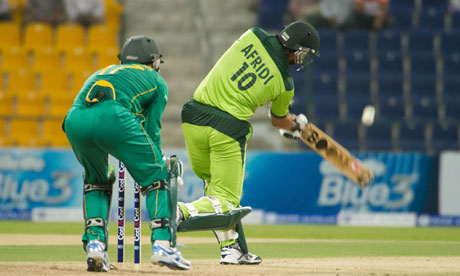
This week, Shahid Afridi became the greatest hitter of sixes in the history of international cricket. Needing only one to break the record of 372 at the start of the third one-day international against South Africa, the Pakistan all-rounder duly leapt out of his crease and barfed his second ball over the ropes at cover. Three balls later he was out, caught behind slashing hungrily.
Afridi is no longer much of a match winner and it would be easy to carp at any list that decrees him, however briefly, a more significant cricketing personage than Virender Sehwag (215 sixes), Sir Viv Richards (210 sixes) and Sir Donald Bradman (six sixes). But this would be to belittle his achievement. Afridi is truly exceptional at one thing: hitting sixes.
Addressing this with a furious literal‑mindedness, he has now done this one thing more often than any other human being in history, racing to the record in 200 fewer matches than the previous holder Sanath Jayasuriya. Afridi deserves his moment. There is something gorgeously incorrigible about his batting, even more so in unreformed, mini-skirted cricketing middle age, still toting about his enduring reserve of small-town Elvis impersonator charisma, still refusing to knuckle down or stop doing all those terribly reckless Afridi things.
If there is a problem with Afridi it is that watching him bat is like watching a man trying to write a novel composed entirely of exclamation marks; or like listening to the world's most brilliant speed-metal guitarist, who unfortunately only knows how to play a wildly exuberant 30-second solo with his moustache. The six-hit in isolation is almost entirely without content. And while Afridi may be a great six-hitter he is not a great player and as such his record tally of swishes and swipes is ultimately meaningless; as is, beyond a certain mild curiosity, the list he now tops.
This is the purist's view – certainly in England where until quite recently the hitting of a six was met with a kind of weary disapproval. The six had something mildly hysterical and flaky and foreign-accented about it. Commentators would sigh. Spin bowlers would lick their fingers pityingly. When England's own batsmen began to hit sixes it seemed oddly transgressive.
Ian Botham pretty much invented the six in this country, notably with his unique squatting ankle-height heave over square-leg, reminiscent of a man gleefully yanking into life the ignition crank on a particularly stubborn petrol‑powered lawn mower. More recently Michael Vaughan's righteous short-arm pull was a wonderful treat, the shot that saw him resemble most clearly in his batting style a notoriously severe 19th century public-school chaplain administering elegant violence with his favoured bamboo switch.
The six is now a far more urgent everyday presence. It is also an agent of modernity. In Twenty20 the six has already replaced taking a wicket as the game's central function, to be forcibly consumed in great glugging, liver‑swelling draughts. There is now a great living to be made in sixes. Afridi himself has his Boom Boom equipment range, not the kind of empire to be teased out of a career-defining mastery of the dab to third man.
The remarkable Australian David Warner still hasn't scored a first-class half-century, but in Twenty20 he bats like a prodigiously talented caveman armed with a light sabre and has duly become, via the Indian Premier League, one of the highest paid batsmen in the world. As a mark of how separate the two codes are now: England's Test specialist Alastair Cook, Warner's shadowy five-day reflection, averages a six every 2,057 balls in international cricket. Warner is currently rocking along at a six every 17 balls, and garnering much global attention with his brand of instant pop grandeur, while Cook the tortured technician still vainly spends his days trying to learn to draw like Rembrandt.
Which is all very well. But what – gripped as the nation is with pre-Brisbane tension – has it got to do with the Ashes? Perhaps there are some lessons to be learnt from Afridi's record. During the recent period of Australian greatness some of this intoxicating six‑culture did filter through to the long game. Steve Waugh's Australian team implemented the tactic of aggressive and muscular fast-scoring as an intimidatory tactic in Test Matches (witness Matthew Hayden thrillingly plonking Andy Caddick into the crowd on the first morning of the 2002 Ashes series). A concussive approach has duly become a part of the Ashes lexicon. This week we have had the usual talk about making statements and going toe-to-toe and the sense that everything hangs on that first great clashing of front row skulls in Brisbane.
But these are different times and different teams. Eight players from the top 50 Test-match six-hitters of all time played in the 2005 Ashes series. Adam Gilchrist, Hayden, Andrew Flintoff, Marcus Trescothick, Justin Langer and Shane Warne (37 sixes! Five more than Garry Sobers!) have all gone now. Only Ricky Pointing and Kevin Pietersen remain. It might be wise to adopt, rather than settle for in retreat, a rather more sedate and attritional approach this time; and perhaps even quite refreshing too









